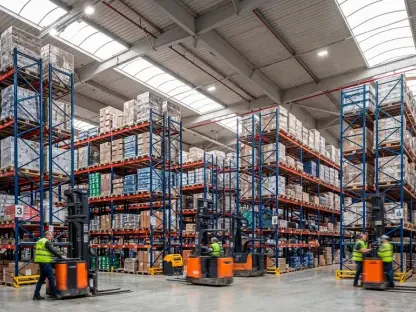Introduction to a Critical Business Imperative
In an era where global supply chains grapple with unprecedented challenges, a staggering statistic emerges: disruptions and inefficiencies cost businesses an estimated $4 trillion annually in lost revenue and excess expenses across industries. This immense financial burden, compounded by volatile economic conditions and shifting consumer expectations, underscores an urgent need for companies to rethink their operational frameworks. Supply chain optimization has swiftly risen to the forefront as a vital strategy for mitigating these pressures, ensuring not just survival but also competitive advantage in a turbulent market landscape. This analysis delves into the evolving trends, real-world applications, expert insights, and future prospects of supply chain optimization, with a particular focus on how leading corporations are navigating these complexities to redefine efficiency.
The Rising Focus on Streamlining Supply Chains
Industry Shifts and Economic Pressures
Across various sectors, supply chain optimization has become a focal point, driven by mounting cost pressures and the need for operational agility. Recent market research indicates that over 70% of global corporations have prioritized supply chain restructuring to combat rising expenses, with efficiency gains projected to save billions annually. The consumer goods industry, in particular, faces significant hurdles from tariffs, inflation, and fluctuating raw material costs, pushing companies to adopt innovative strategies to maintain profitability. These economic drivers highlight a broader trend where optimization is no longer optional but a critical component of business resilience.
Moreover, the past few years have seen a sharp increase in supply chain investments, as major firms recognize the necessity of robust networks to withstand disruptions. Reports show that logistics and transportation costs have surged by nearly 20% since early 2025, compelling organizations to seek smarter ways to manage resources. This urgency is further fueled by unpredictable consumer behavior, with demand patterns shifting rapidly due to economic uncertainty, forcing businesses to adapt their distribution models to stay relevant in a competitive arena.
Economic volatility remains a key motivator for these sweeping changes, as companies grapple with external challenges that threaten margins. Industry analyses emphasize that without proactive measures to streamline operations, firms risk falling behind in an increasingly dynamic global marketplace. The push toward optimization reflects a strategic response to these multifaceted pressures, ensuring that supply chains are not just cost-effective but also flexible enough to handle sudden market shifts.
Practical Applications: Colgate-Palmolive’s Strategic Moves
One prominent example of supply chain optimization in action is Colgate-Palmolive’s ambitious $300 million productivity program, launched in the current year. This three-year initiative places a strong emphasis on refining the company’s global supply chain to enhance efficiency and reduce overhead costs. Announced during the second-quarter earnings call, the program aims to address contemporary economic challenges while bolstering the firm’s ability to meet evolving consumer needs with precision.
Building on previous efforts, such as a streamlining initiative completed just last year, Colgate-Palmolive demonstrates a consistent commitment to operational excellence. That earlier project focused on cutting structural costs through supply chain enhancements, laying the groundwork for the current, more expansive plan. This pattern of iterative improvement signals a long-term vision to maintain agility amid rising costs and external pressures like tariff fluctuations.
Comparatively, competitors such as Procter & Gamble have embarked on parallel restructuring projects, targeting network reorganization to achieve similar efficiency gains. This convergence of strategies across the consumer goods sector points to a widespread industry trend, where supply chain optimization serves as a cornerstone for navigating economic headwinds. Such real-world implementations underscore the tangible impact of these efforts on maintaining market competitiveness.
Insights from Industry Leaders
Expert opinions shed light on the strategic importance of supply chain agility in today’s economic climate. Colgate-Palmolive’s CFO, Stanley Sutula, highlighted during the recent earnings discussion that optimizing the supply chain is pivotal to reallocating resources effectively, though specifics of the plan remain under wraps. This perspective reinforces the idea that streamlined operations are essential for balancing cost reduction with market responsiveness.
Similarly, CEO Noel Wallace emphasized the strength of the company’s global network in addressing fluctuating consumer preferences, such as the shift between multipacks and smaller product sizes driven by economic uncertainty. His remarks point to the necessity of a resilient supply chain capable of adapting to dynamic demands without compromising efficiency. These executive insights reflect a broader consensus on the role of optimization in sustaining growth under challenging conditions.
Industry analysts also weigh in, noting potential obstacles in achieving these goals, such as the delicate balance between cutting costs and maintaining quick response times to market changes. External factors like tariffs, though recently revised downward to a projected $75 million impact for Colgate-Palmolive, still pose significant risks. These expert views collectively validate the critical nature of supply chain strategies in overcoming economic barriers while meeting consumer expectations.
Looking Ahead at Supply Chain Innovations
The future of supply chain optimization appears poised for transformation, with emerging technologies like automation and data analytics expected to redefine operational capabilities. These advancements promise to enhance visibility and decision-making, enabling companies to anticipate disruptions and adjust processes in real time. As firms integrate such tools over the next few years, the potential for cost efficiency and adaptability could reach unprecedented levels.
However, the path forward is not without challenges, as significant investment costs and integration complexities may hinder rapid adoption. Businesses will need to weigh the long-term benefits of these innovations against immediate financial constraints, ensuring that technology aligns with strategic objectives. The successful implementation of these solutions could set industry leaders apart, creating a ripple effect across global trade networks.
Beyond individual companies, the sustained emphasis on supply chain resilience holds broader implications for pricing dynamics in consumer goods and other sectors. While improved efficiency may lead to more stable costs for end users, risks such as over-reliance on technology or unforeseen geopolitical shifts could introduce new vulnerabilities. This dual nature of progress—offering both opportunities and uncertainties—will likely shape the evolution of supply chains in the coming years.
Reflecting on Past Actions and Future Steps
Looking back, the journey of supply chain optimization reveals a landscape where economic pressures necessitated bold, strategic responses from industry players. Companies like Colgate-Palmolive took decisive steps to refine their operations, setting a precedent for others to follow in mitigating cost burdens and adapting to consumer shifts. Their efforts underscored a pivotal shift in how businesses view supply chains—not as static systems, but as dynamic assets requiring continuous improvement.
Moving forward, organizations must prioritize investments in scalable technologies and flexible frameworks to stay ahead of evolving challenges. Exploring partnerships and cross-industry collaborations could further enhance resilience, offering shared solutions to common disruptions. By committing to these proactive measures, businesses can transform potential vulnerabilities into strengths, ensuring sustained success in an ever-changing global market.









